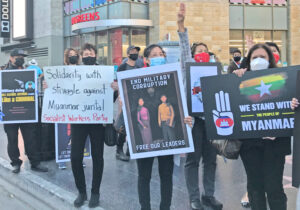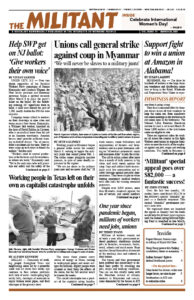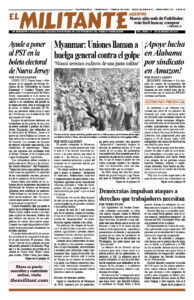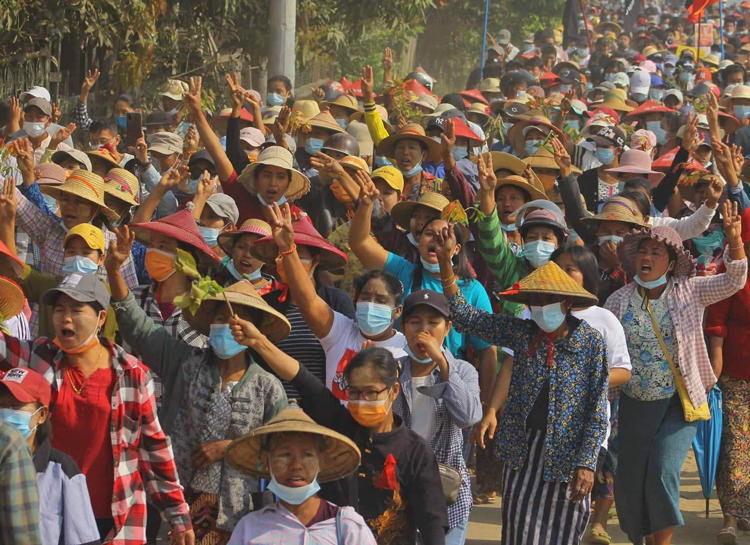Working people in Myanmar began a general strike across the country March 8, seeking to topple the military junta that seized power Feb. 1. The strike comes alongside massive protests, in spite of more deadly repression by the regime.
“We are not slaves to the military junta now and we never shall be,” 18 trade unions, union federations and organizations of farmers and farmworkers said in a joint statement, calling on “all workers nationwide, union and nonunion alike” to join the strike.

The call to action comes after more than a month of daily protests in big cities and rural towns against the coup. Cops and soldiers have increasingly used live ammunition and vicious beatings against peaceful demonstrators. They were caught on video beating emergency medical workers with rifle butts for treating wounded protesters.
Despite over 2,000 arrests, more than 60 deaths, hundreds injured, the use of torture, and untold numbers “disappeared,” protesters keep pouring into the streets.
If anything, the attacks by the police and army have brought workers, farmers and youth; Buddhist, Hindu, Muslim and Christian religious leaders; and ethnic minorities closer together.
The demonstrators are not naive about what they face. Kyal Sin, 19, shot dead during a March 3 protest in Mandalay with a bullet behind her ear, had posted on Facebook that if she were killed she wanted her organs donated to save other lives.
The depth of the protests has surprised even longtime opponents of the military high command. Kyaw Zwa Moe — a veteran of the 1988 uprising that was crushed in blood by the generals — wrote in Irrawaddy, a Yangon-based news service that supports the protests, that two days after the killing of Kyal Sin, “we were amazed to see photos of still bigger crowds of protesters taking to the streets in Mandalay.”
After the strike call, police and soldiers began occupying hospitals, universities and schools to use as base camps. According to Irrawaddy, they fired guns throughout the night in Yangon in an attempt to intimidate people. The repressive forces also are stopping cars and pedestrians and arresting those who have anti-regime literature.
Decades of military rule
Under Myanmar’s 2008 constitution, imposed by the generals as part of allowing a controlled “democratic” opening after decades of military rule, 25% of the seats of parliament are appointed directly by the commander-in-chief of the Armed Forces, giving him veto power over any changes to the constitution. Key ministries are also appointed by the military.
In 2016, Aung San Suu Kyi, head of the bourgeois National League for Democracy, became de facto head of government after her party won a landslide electoral victory the year before, the first contested election in decades.
Suu Kyi’s standing flows from the reputation of her father, Aung San, who was killed during the struggle for independence from British colonial rule, as well as her years of imprisonment by the military.
Despite her earlier reputation as an opponent of the military rulers, she has become the main public defender of the army’s repression of the Rohingya minority in Rakine province.
Suu Kyi is also widely mistrusted by many from ethnic minorities mistreated by the military and the government. Divisions between the ethnic minorities — more than 30% of the population — and the ruling Bamar majority are a legacy of British colonial rule and its strategy of divide and rule. After Myanmar won its independence in 1948, the post-independence regimes continued to foster those divisions, including the military regimes waging war against their struggles for autonomy.
After 2016, the National League for Democracy overturned some laws that restricted democratic rights and passed legislation weakening the generals’ control of lucrative businesses, like their trade in jade. The generals feared that there would be more pressure to limit their economic and political power after the National League for Democracy won an even bigger margin in the November 2020 elections.
Burmese ‘socialism’
The military high command played a key role in capitalist development in Myanmar in 1963, the year after Gen. Ne Win deposed the civilian government. Claiming they were organizing “the Burmese Way to Socialism,” the junta nationalized foreign banks and many businesses.
These nationalizations without a revolution — like similar expropriations carried out by the military castes in Egypt and Syria — had nothing to do with eliminating capitalism or advancing the interest of working people. Instead, they served as an incubator for a native capitalist class, primarily from the Bamar ethnic majority, especially those with ties to the military.
Senior military officers and their families gained control of the most lucrative businesses and industries. This accelerated in 2011 when state-owned businesses were sold off, often to military officials and their cronies. This was coupled with a major expansion of foreign investment from companies based in China, Singapore, Japan, the United Kingdom and the U.S.
The influx of capital and expanded production meant a growth in the size of the working class along with union organization and struggles. Myanmar has become a major center for world garment production, with some 600,000 workers who earn even less than their counterparts in Vietnam and Cambodia.
Hundreds of thousands of farmers — many of them members of ethnic minorities from the outer provinces — are being driven off the land and into the factories in Yangon and Mandalay. One unintended consequence of this migration has been that many workers from different ethnic minorities find themselves side by side in garment and other factories, fighting together against exploitation by the bosses and their military cronies. This solidarity finds its way back to their villages.
Some 2,500 residents from 34 farm villages in Mu Traw District, an area that is predominantly settled by the Karen minority, issued a statement March 2 pledging “our solidarity and support with all the protesters rising up against the military dictatorship. We will continue to fight for our rights until we achieve the establishment of a genuine democratic federal union with ethnic equality and self-determination.”


